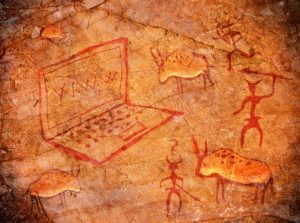
A screen saver is a feature that will either blank out your screen or display a series of moving patterns or images so anything open on your screen is hidden if your computer is left idle for a certain amount of time.
Historically, screen savers were created to prevent “burn-in”, which happened when a computer was left running while unused. If left too long, whatever the screen was displaying would become “burnt” into the screen, creating ghost images, so by bringing up a moving animation, it literally saved the screen from damage. Today screen savers are primarily used for entertainment or security.

To turn your screen saver on, right click the desktop of your computer, and select “Personalize” and then click on “Screen Saver” in the bottom right hand corner. Once you select a screensaver from the dropdown list, you will be able to see a small preview of it within the dialogue box, or you can click the “Preview” button to see what it will actually look like.

Some screen savers have settings you need to set. For example if you select the “Photos” screen saver, you will need to click the “Settings” button then the “Browse” button to select the folder that contains the images you want to display. It is also a good idea to tick the “On resume, display logon screen” because this locks your computer when the screen saver turns on, adding some extra security.







